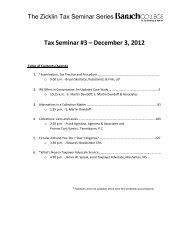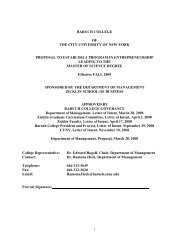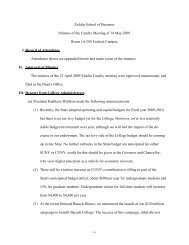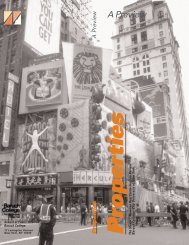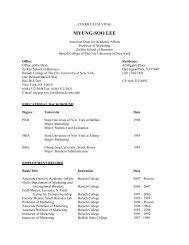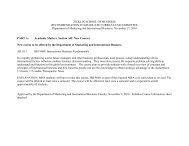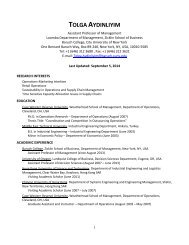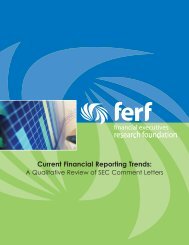Valueat-Risk
Forecasting the Return Distribution Using High-Frequency Volatility ...
Forecasting the Return Distribution Using High-Frequency Volatility ...
- No tags were found...
You also want an ePaper? Increase the reach of your titles
YUMPU automatically turns print PDFs into web optimized ePapers that Google loves.
1. GARCH(1,1): GARCH(1,1) model with standard normal innovations<br />
2. GARCH(1,1)-t: GARCH(1,1) model with t k innovations<br />
3. GARCH(1,1)-EDF: FHS with a GARCH(1,1) conditional variance<br />
4. EGARCH(1,1)-EDF: FHS with a EGARCH(1,1) conditional variance<br />
5. GJR: GJR-GARCH(1,1) with standard normal innovations<br />
6. GJR-EDF: FHS with a GJR-GARCH(1,1) conditional variance<br />
The first three models share the same conditional variance specification but differ in the distributional<br />
assumption for the error term. The remaining models allow for the leverage effect which<br />
is combined with normal errors or with errors resampled from the EDF. In this case we choose<br />
the number of replications B equal to 10000. In comparing these volatility models, we use the<br />
GARCH(1,1)-EDF and GJR-EDF as the benchmark models against which we evaluate the remaining<br />
five models. We evaluate the density, quantile and interval forecasts generated by these models<br />
using the predictive accuracy tests discussed in Section (4). In all cases, the test statistics are<br />
standard normal distributed and rejections of the null hypothesis of equal (average) accuracy for<br />
negative values indicate that the benchmark model (GARCH(1,1)-EDF or GJR-EDF) is (significantly)<br />
outperformed by the alternative model.<br />
S&P 500 Return (SP)<br />
Table (2) shows the t-statistic of the Log-Score (LS) and the Weighted Quantile Score (WQS)<br />
for h equal to 1, 2, and 5. Two findings emerge from the comparison of the volatility models to<br />
the GARCH(1,1)-EDF benchmark. First, the positive LS test statistics obtained by comparing<br />
the benchmark to the GARCH(1,1) model with normal and t distributed errors suggest that these<br />
models are significantly less accurate (compared to the benchmark) at all forecast intervals h. Similar<br />
findings are provided by the WQS with uniform weight at the 1 and 5 day horizons. In addition,<br />
the WQS statistics show that, at all horizons, the GARCH(1,1)-EDF has similar performance to<br />
the models with normal and t distributed errors on the left tail of the return distribution, but it<br />
is significantly more accurate on the right tail. It is thus the case that the three distributional<br />
assumptions provide similarly accurate forecasts when modeling negative returns, but the EDF<br />
assumption provides more precise forecasts of the right tail compared to the parametric distributions.<br />
This suggests that in the forecasting period 2000-2009 the (out-of-sample) evidence does not support<br />
the use of the t distribution for the error term. In addition, the nonparametric nature of the EDF<br />
allows to capture some asymmetry in the error distribution which is not accounted for by the<br />
parametric distributional assumptions. Comparing the GARCH(1,1)-EDF to the EGARCH and<br />
GJR models, it appears that the LS and WQS-uniform tests are significantly negative at the 1<br />
and 2 day horizons, but only the GJR-EDF specification outperforms the benchmark for h=5.<br />
Furthermore, at the 1-day horizon we observe rejections for negative values of the WQS focused<br />
on the left and right tails, but mostly on the right tail for h=2 and at the 5-day horizon. Hence,<br />
including a leverage effect in the conditional variance specification is important in modeling the<br />
return distribution, but this effect seems less pronounced when the object of interest is the multiperiod<br />
cumulative return. When considering the GJR-EDF model as the benchmark, the Table<br />
13



